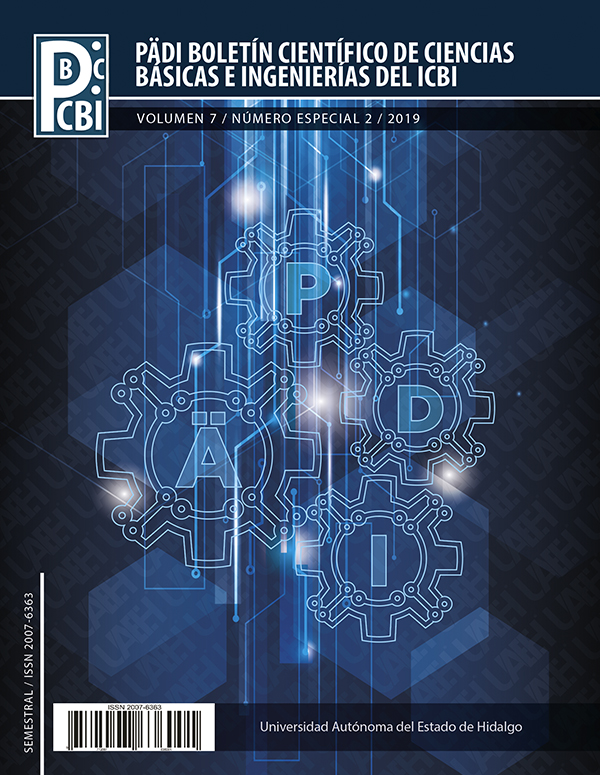Rare Earth Recovery Through Cation Exchange, Using Natural Bentonite: Preliminary Study
Abstract
The use of rare earths in current innovations, which have allowed the technological development of industries such as computing, electronics, robotics, automotive, etc., highlights the need to find new ways to obtain these elements from primary and secondary sources. That is why, the present work shows the most important preliminary results, related to the adsorption of some rare earth elements and precious metals, using a natural mineral, such as bentonite. Thus, experiments were carried out to recover the aforementioned elements (Ce, La, Nd, Yb, Pd and Au) contained in synthetic solutions, and in solutions from the leaching of a SEDEX type mineral from the state of Hidalgo, in Mexico. In all cases, the Cation Exchange Capacity (CEC) of natural bentonite was evaluated as a function of pH, finding that this parameter has no significant effect on the CEC of bentonite, achieving 100% recoveries in the case of Ce and La, and above 99% for the rest of the elements in both types of solutions (synthetic and from leaching), and with this, it is preliminary concluded that natural bentonite (without activating), is a material that can be used, in addition to support in the drilling of oil wells and in the manufacture of molds and cores in the metallurgical and steel industry, to recover values of precious metals and rare earth elements.
Downloads
References
Alshameri, A., He, H., Xin, C., Zhu, J., Xinghu, W., Zhu, R., & Wang, H., 2019. Understanding the role of natural clay minerals as effective adsorbents and alternative source of rare earth elements: Adsorption operative parameters. Hydrometallurgy 185, 149 – 161.
Bickmore, B.R., Rosso, K.M., Nagy, K.L., Cygan, R.T., Tadanier, C.J. 2003. Ab initio determination of edge surface structures for dioctahedral 2:1 phyllosilicates: Implications for acid-base reactivity. Clays and Clay Minerals 51 (4), 359 – 371.
Cerecedo, E., Rodríguez, V., Hernández, J., Mendoza, D., Reyes, M.I., Moreno, E. and Salinas, E. 2018. Mineralization of rare earths, platinum and gold in a sedimentary deposit, found using an indirect method of exploration. Aspects in Mining & Mineral Science 1 (2), 1 – 9.
Chi, R. 1989. Extraction of Rare Earths from a Low-Grade, Kaolinitic Ore by Percolation Leaching. Rare Earths. Extraction, Preparation and Applications. The Minerals, Metals and Materials Society (1988), pp. 227–234.
Churakov, S.V. 2006. Ab initio study of sorption on pyrophillite: Structure and acidity of the edge sites. The Journal of Physical Chemistry B 110, 9, 4135–4146.
Churakov, S.V. 2007. Structure and dynamics of the water films confined between edges of pyrophyllite: A first principle study. Geochimica et Cosmochimica Acta 71 (5), 1130–1144.
Fu, F., Wang, Q. 2011. Removal of heavy metal ions from wastewaters: A review. Journal of Environmental Management 92, 407-418.
Hernández, J. G. 2015. Condiciones para el empleo de bentonita en un fluido de perforación base agua de mar en función del comportamiento hidráulico. (Tesis de licenciatura publicada) Universidad Nacional Autónoma de México.
Hernández, J., Salinas, E., Cerecedo, E., Reyes, M.I., Arenas, A., Román, A.D, & Rodríguez, V. 2017. Diatoms and Their Capability for Heavy Metal Removal by Cationic Exchange. Metals, 7(5), 169, 1 – 10.
Moldoveanu, G.A., Papangelakis, V.G., 2012. Recovery of rare earth elements adsorbed on clay minerals: I. Desorption mechanism. Hydrometallurgy 117-118, 71–78.
O’Connell, D. Birkinshaw, C. O’Dwyer, T., 2008. Heavy metal adsorbents prepared from the modification of cellulose: A review. Bioresource Technology 99, 6709 – 6724.
Roldán, E., Hernández, J., Cerecedo. E., Reyes, M.I., Salinas, E. 2018. Use of the System S2O3(2-)-O2 for the Leaching of Precious Metals Contained in a Mineral From Molango in the State of Hidalgo, Mexico. European Scientific Journal ESJ 14 (3), 48 - 54.
Stackhouse, S., Coveney, P.V., Sandre, E. 2001. Plane-wave density functional theoric study of formation of clay-polymernanocompositematerialsbyself-catalyzedinsituintercalativepolymerization. Journal of the American Chemical Society 123, 47, 11764 – 11774.
Suter, J.L., Kabalan, L., Khader, M., Coveney, P.V. 2015. Ab initio molecular dynamics study of the interlayer and micropore structure of aqueous montmorillonite clays. Geochimica et Cosmoschimica Acta 169, 17–29.
Sweetman, S.C. 2006. Martindale: guía completa de consulta farmacoterapéutica. Pharma.
Toja, R. J., 2016. Propiedades de una bentonita industrial nacional y su caracterización estructural basada en absorción y difracción de rayos X (XANES y DRX). (Tesis de doctoral publicada) Universidad Nacional de la Plata; Argentina.













